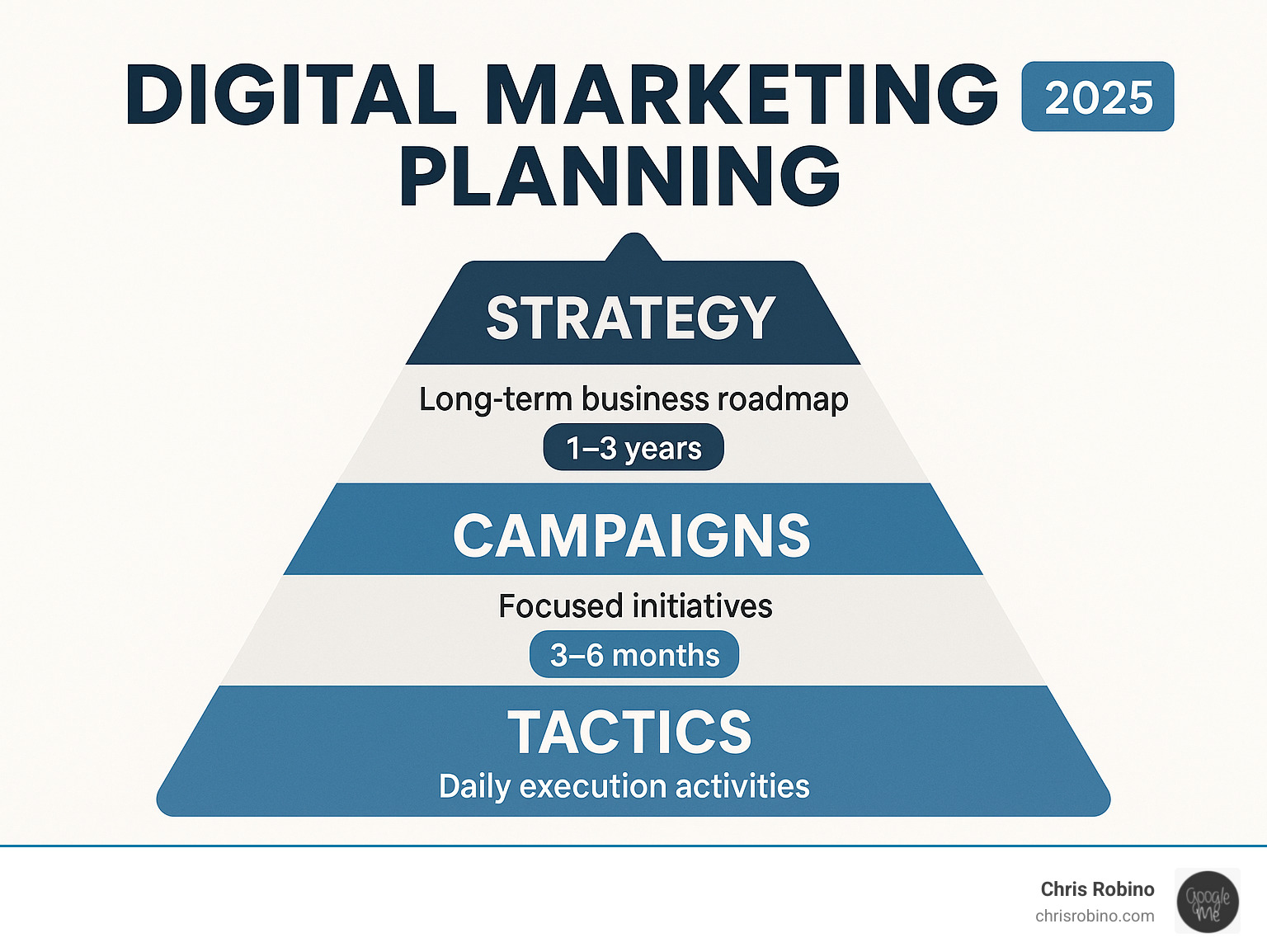Why Most Digital Marketing Strategy Advice Falls Flat (And What Actually Works)
Digital marketing strategy advice is everywhere, but most of it is corporate jargon. The reality is that almost half (47%) of companies lack a planned digital marketing strategy, often just throwing content at the wall and hoping something sticks.
Effective digital marketing isn’t about posting more; it’s about having a real plan. A digital marketing strategy is your long-term roadmap for achieving specific business goals through digital channels. It’s not the same as tactics (the day-to-day stuff) or campaigns (focused, time-bound initiatives).
- Strategy is your why and where.
- Campaigns are your what.
- Tactics are your how.
The challenge is that technology and consumer behaviors are constantly evolving. You need a strategy that’s both structured and flexible.
I’m Chris Robino, and I’ve spent over two decades helping organizations build digital marketing strategies that drive results. My approach integrates AI-driven systems with proven frameworks to maximize ROI while keeping things simple.

First, Nail the Fundamentals (Don’t Skip This!)
Everyone wants to jump to flashy tactics like viral videos and AI chatbots, but successful digital marketing is built on rock-solid fundamentals. Master these, and you’ll outperform 90% of your competition who are busy chasing shiny objects.

Foundational digital marketing strategy advice: Start with Why
Businesses often start a blog because “content is king” without asking why it connects to their goals. A real strategy is a plan to beat specific challenges. Every effective strategy needs three parts to any strategy: a clear diagnosis of the problem, a guiding policy for your approach, and targeted actions to bring it to life.
For example, your diagnosis might be low brand awareness. Your guiding policy could be to establish thought leadership. Your targeted actions would then be the specific content and channels you use. Without this backbone, your marketing efforts will be busy but not productive. This is the hard work that builds a solid foundation.
The Holy Trinity: Owned, Earned, and Paid Media
Your online presence is a combination of three media types. You need all three for stability.
| Media Type | Description | Control | Cost | Trust |
|---|---|---|---|---|
| Owned | Assets you control (website, blog, social profiles) | High | Low (ongoing maintenance) | Moderate |
| Earned | Third-party mentions (PR, reviews, shares) | Low | Free (earned via merit) | High |
| Paid | Channels you pay for (PPC, social ads) | High | Varies (bid-based) | Low-Moderate |
Your website is your digital headquarters. Owned media like your blog and social profiles extend your reach. Earned media is the holy grail, offering powerful third-party credibility. Paid media like Google Ads provides speed and precision. The magic happens when all three work together to build your foundation, amplify credibility, and accelerate reach.
Know Your Audience: Building Buyer Personas
Knowing your audience means building detailed, research-backed profiles of your ideal customer. A buyer persona goes beyond basic demographics to understand their pain points—the problems that keep them up at night.
It also involves understanding their online behavior: Where do they spend time online? Which social platforms do they use? How do they research products? This isn’t guesswork; it’s market research that leads to data-driven decisions. Use buyer persona templates to gather this data systematically.
When you truly understand who you’re talking to, your content resonates, your channel selection makes sense, and your messaging connects. It’s the difference between shouting into a crowd and having a meaningful one-on-one conversation.
Your 5-Step Blueprint for a Winning Strategy
Now let’s build something that works. This isn’t a fancy framework for a PowerPoint; it’s a practical, step-by-step approach to guide you from scattered efforts to focused growth.

Step 1: Set SMART Goals, Not Vague Wishes
“We want more sales” is a wish, not a goal. Effective digital marketing strategy advice relies on SMART goals: Specific, Measurable, Achievable, Relevant, and Time-bound. They force you to be honest about what you’re trying to achieve.
A real SMART goal looks like this: “Increase website traffic by 30% through organic search within 12 months.” Or “Generate 50 qualified leads per month through content marketing by Q3.” A helpful approach is to structure goals around the customer journey, from brand awareness to sales growth.
Step 2: Audit Your Current Digital Channels
Before you build, you need to know what’s already working. This is about being smart with your resources.
- Website Analytics: Use Google Analytics to see where traffic comes from, what pages are popular, and where people leave.
- Social Media Engagement: Look beyond likes to comments, shares, and other meaningful interactions.
- SEO Rankings: Are you visible for the keywords that matter to your business?
- Content Gaps: What does your audience need that you aren’t providing?
- Competitor Analysis: Learn from what others in your space are doing successfully.
This audit creates your baseline for measuring future success.
Step 3: Establish Your Budget and Resources
Money and time make or break every strategy. While marketing budgets often hover around 10% of total business revenue, your situation is unique. Just as important is your time commitment. Digital marketing requires consistent effort and adaptation.
Be realistic about the hours you can dedicate and whether you have the right team roles and tech stack. It’s better to do fewer things well than many things poorly. Go Make Mistakes, but do so strategically within your means. For insights on resource allocation, see Innovation In Media Companies.
Step 4: Plan Your Content and Choose Your Levers
Now, choose your channels and tactics. The key is integration, not isolation.
- Content Marketing: Create valuable content (blogs, videos, guides) that solves problems and builds trust.
- SEO: Ensure people can find your content when they search for solutions.
- Video Marketing: With the vast majority of companies considering video a crucial part of their digital marketing strategy, it’s essential for connecting with audiences.
- Social Media Marketing: Build relationships and engage directly with your audience.
- Email Marketing: Nurture leads and retain customers with one of the highest ROI channels.
- PPC Advertising: Use Google Ads and social platforms for quick, targeted results.
The magic happens when these levers work together in a coordinated symphony.
Actionable Digital Marketing Strategy Advice for Real Growth
The difference between strategy and execution is results. This section provides digital marketing strategy advice that turns your blueprint into measurable growth.
Dominate Search with High-Value Content
Modern SEO is simple: create content that genuinely helps people. Start with keyword research to understand user intent—what someone is trying to accomplish with their search. Your on-page SEO should feel natural; write for humans first, not just search engines.
Effective link building happens when you create content worth linking to, establishing you as a thought leader. Consistent blogging is the foundation. Organize your content into topic clusters, with broad “pillar pages” linking to more specific articles. SEO is a marathon, but the resulting organic traffic is highly valuable.
Engage and Convert with Video and Social Media
If content is king, video is the emperor. Short-form video on platforms like TikTok and Instagram Reels is perfect for showing your brand’s personality. The key is authenticity, not polish.
Encourage user-generated content by running contests or creating hashtags. It’s marketing gold because it’s authentic and trustworthy. Community management is also crucial—social media is a conversation, not a broadcast. Respond to comments and build genuine relationships.
Don’t try to be everywhere. Platform selection should be based on where your target audience is most active. Focus on engagement metrics like comments and shares, not just likes. True influence comes from genuine connection, not just follower counts, a concept I explore in Influence Flu.
Advanced digital marketing strategy advice for large enterprises
Large organizations require sophisticated digital marketing strategy advice that scales.
- Enterprise SEO: This involves managing massive websites across multiple domains and languages, requiring deep technical expertise in site architecture and international SEO.
- Scalable Content Systems: To manage content across teams and brands, enterprises need robust content management systems, clear governance, and often AI-assisted creation to maintain quality at scale.
- Programmatic Advertising: This uses AI to automate ad buying in real-time, optimizing bids across thousands of platforms to reach the right audience at the right price.
- Data Integration: The biggest challenge is often unifying customer data from disparate systems (CRM, analytics, sales). A unified view enables personalization and accurate measurement.
- Multi-channel Attribution: Advanced models help you understand which touchpoints contribute to conversions across complex customer journeys, moving beyond last-click attribution.
For enterprises, leveraging Cloud Solutions For Media can provide the necessary scalability. Staying ahead of Media Industry Trends 2024 is also critical for maintaining a competitive edge.
Measure, Adapt, and Evolve: Your Strategy is a Living Thing
Your digital marketing strategy advice isn’t a static document. It’s a living entity that needs constant monitoring and evolution to keep pace with the rapidly changing digital landscape.
Tracking What Matters: Key Performance Indicators (KPIs)
To know if your strategy is working, you must track the right metrics. Key Performance Indicators (KPIs) are the values that show how effectively you’re achieving your objectives.
- Return on Investment (ROI): How much revenue are your marketing efforts generating compared to their cost?
- Customer Acquisition Cost (CAC): How much does it cost to acquire a new customer?
- Conversion Rate: The percentage of users who complete a desired action.
- Website Traffic: The number of visitors to your site, broken down by source.
- Engagement Rate: Social media interactions relative to your reach.
Tools like Google Search Console and Google Analytics are essential for tracking these KPIs and identifying areas for optimization.
The Role of AI in Modern Strategy
Artificial Intelligence (AI) is a powerful tool in modern marketing. Generative AI can assist with content creation and strategy brainstorming. Predictive Analytics can forecast trends and customer behavior. AI also enables personalization at scale and automates repetitive tasks, increasing efficiency. You can even use AI-powered tools to evaluate and grade your content’s search performance.
Staying Agile in a Changing Market
The digital world is dynamic. Your strategy must be agile.
- Continuous Improvement: Adopt a “test, learn, refine” mentality.
- A/B Testing: Test different versions of ads, landing pages, and emails to see what performs best.
- Customer Feedback Loops: Actively solicit and listen to customer feedback.
- Market Monitoring: Keep an eye on industry trends and competitor activities.
The ability to adapt quickly is a competitive advantage. It’s about being in a state of continuous improvement, as explored in Wander In Focus Out.
Frequently Asked Questions about Digital Marketing Strategy
Here are concise answers to common questions about digital marketing strategy advice.
How is a digital marketing strategy different from a marketing campaign?
A strategy is your long-term, overarching plan that guides all marketing toward your main business goals. It’s your “why.” A campaign is a short-term, focused initiative designed to achieve a specific objective within that strategy, like a product launch. It’s your “what.”
How much time and money should I commit to digital marketing?
There’s no single answer, but consistency is key. As a benchmark, many businesses allocate around 10% of total revenue to marketing. More important than the exact amount is a sustained commitment of both time and money. Digital marketing is a marathon, not a sprint, and typically takes 3-6 months to show significant ROI. Start with a realistic, sustainable budget and scale as you see results.
How do I measure the success of my strategy?
Success is measured by tracking Key Performance Indicators (KPIs) that are tied directly to the SMART goals you set. If your goal is lead generation, track conversion rates and cost per lead. If it’s sales, track customer acquisition cost (CAC) and return on investment (ROI). Use tools like Google Analytics to gather data, but the real key is to analyze that data to understand what’s working and adapt your strategy accordingly.
Conclusion
We’ve covered a lot, from foundational digital marketing strategy advice to actionable steps for growth. The key takeaway is this: a strong digital marketing strategy is about being intentional and effective, not just being online. It’s the plan that connects your daily activities to your most important business goals.
This is a long-term game that requires consistency and a willingness to adapt. There are no magic bullets. With a well-defined strategy grounded in fundamentals, you move from hoping your marketing works to knowing it will. You stop guessing and start growing.
The digital landscape will always evolve, but if you’ve built your strategy on a solid foundation—understanding your audience, creating value, and measuring what matters—you’ll be ready for whatever comes next. As explored in The Soul Of An Entrepreneur, success comes from consistent action guided by a clear vision.
By implementing these frameworks, you’re not just throwing content at the wall; you’re building a sustainable engine for growth. For professionals in tech and media, a strategic foundation makes all the difference.
Ready to build a strategy that actually works? Explore how to lead an Optimizedlife and transform your approach from scattered tactics into focused, results-driven growth.


